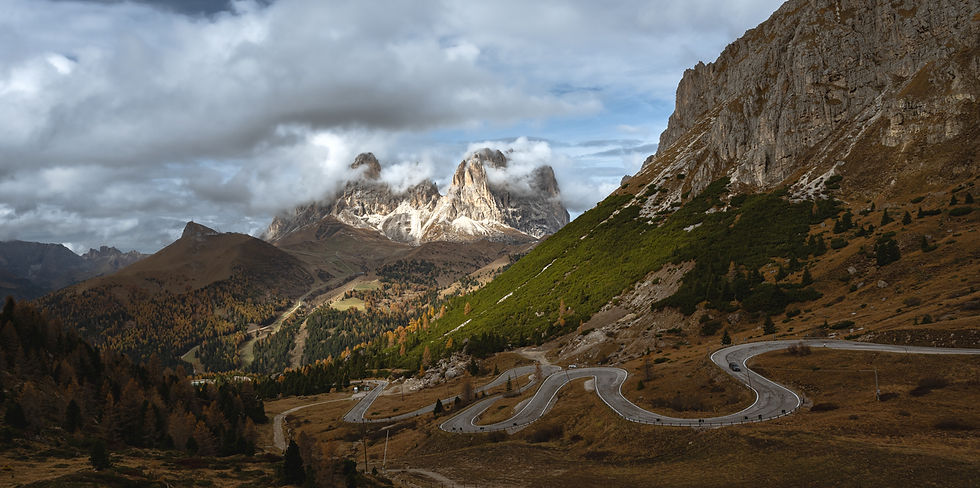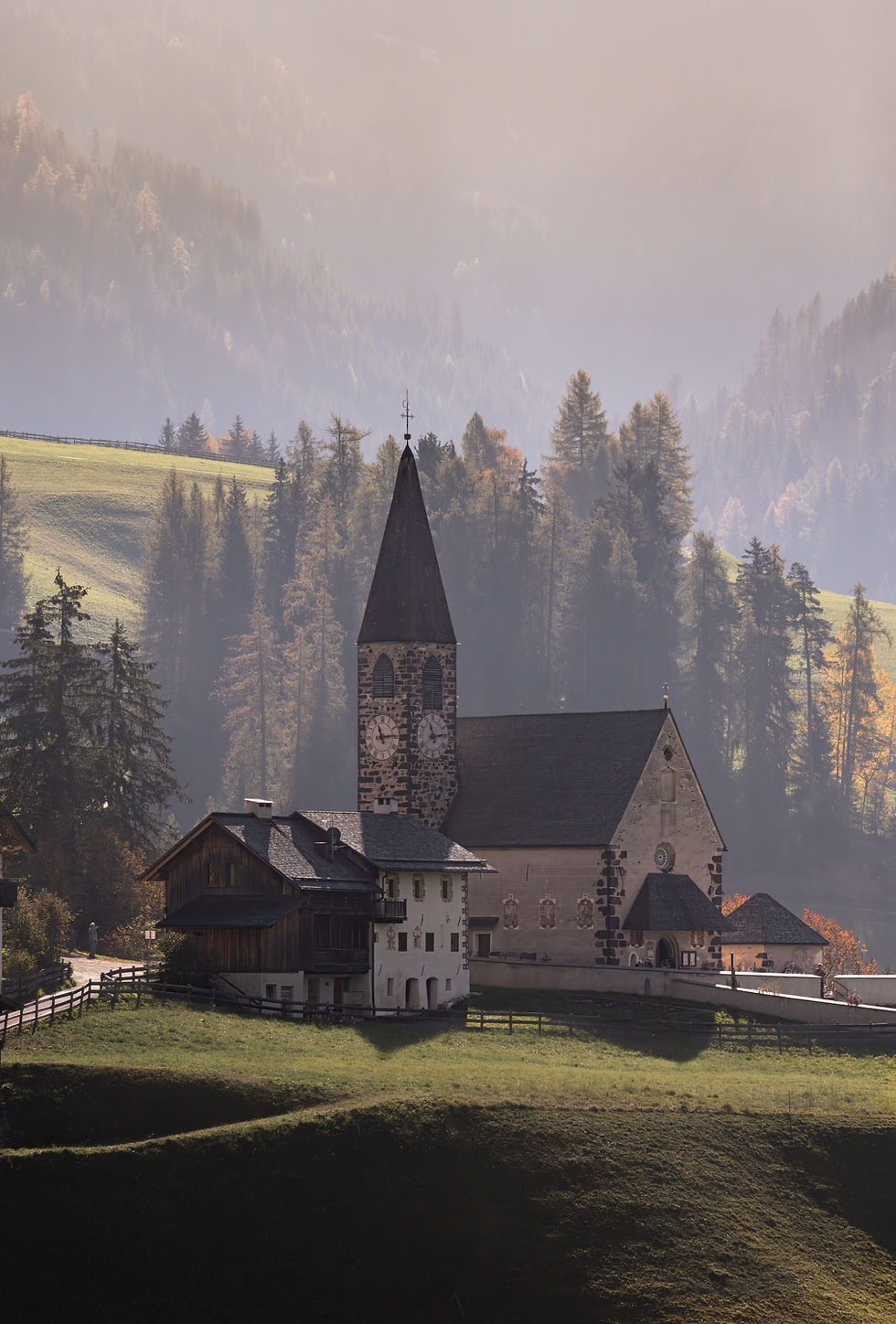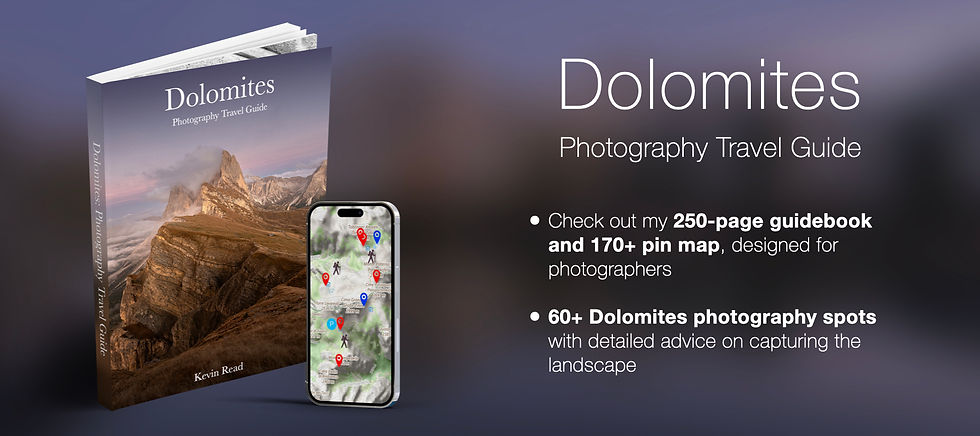How to Get Around the Dolomites for Photography
- Kevin Read

- Jul 13
- 7 min read
Updated: Sep 11
This article is part of the Complete Guide to Photography in the Dolomites

The most rewarding Dolomites photography locations are scattered across valleys and mountain peaks, and you will need to combine different ways of getting around to access everything you might want to see for your trip.
The Dolomites have an extensive network of roads, hiking trails, cable cars, and buses, but no single mode of transport can get you to every place you might want to capture. Getting on location for the best light often means working with and around the available options, and you may need a good plan to reach the best photography spots in these mountains.
Driving in the Dolomites

For most photography adventures, driving is the only viable way to access locations for the best light at the beginning and end of the day. You may need to combine driving with hiking or cable cars to reach some of the more remote locations, but having your own car will often be the only way to reach the best spots for sunrise and sunset photography.
Renting a Car
It is usually easy and relatively cheap to rent a car in Italy, and you’ll have a wide range of options at larger airports if you fly to the Dolomites.
There are fewer rental car options in the mountains, and you should factor in renting a car when planning your journey, which might involve flying to somewhere like Venice, where you’ll have a better choice of rental cars before driving the rest of the way.
Most rental agreements include basic insurance and a high excess, sometimes up to several thousand euros. Purchasing insurance with the car rental agency can be a huge extra cost that you may need to factor in. You may be able to find excess insurance in your home country, which allows you to drive on the basic insurance but claim back the excess if you damage the vehicle. This approach can make car rentals much cheaper, but you should check carefully to ensure your rental car is properly insured and you understand the risks.
You may need to get an International Driver’s Licence to rent a car in Italy, depending on where your licence was issued (check with your local government and rental car agency). The most common reason for needing an International Driver’s Licence is when the alphabet on your licence does not match the one used in the country you’re visiting.
Roads in the Dolomites
Roads in the Dolomites are well maintained and usually wide enough for two cars to pass, though some smaller routes are narrower with frequent passing areas. There are many switchbacks and steep inclines, although most roads have safety barriers and no unguarded drop-offs at the side. Driving in the Dolomites is mostly relaxing and fun, and not the terrifying experience that some mountain roads can be.
Cars coming uphill have right of way, and you need to look out for cyclists, as this is a very popular area to explore by bike. Road rules and parking restrictions are often enforced in these areas because it is so popular with visitors, so be careful to stick to the speed limits, drive sensibly, and always park off the road.
Most roads in the Dolomites are open and unrestricted, but there can be some traffic management in peak season, and you should research any journey to a popular location before you set out.
Some spots close to private vehicles during peak season, there's a toll road to reach Tre Cime di Lavaredo, and many alpine meadows only allow private traffic in the early morning and evening. You don’t need to learn every restriction, but it’s often worth researching your route to popular locations in peak season.
Driving Conditions
Each season brings different challenges for driving in the Dolomites, and you should consider the factors that might affect your journeys at different times of year.
Summer: Almost all roads will be open and may be busy. Driving is an easy way to get around, but check for road restrictions and traffic management at more popular locations.
Autumn: You can experience a range of conditions in autumn, and you may encounter the first snow on the roads by October. Driving at high altitude might be more difficult if the conditions are bad, and the road to Tre Cime di Lavaredo often closes in the snow. Autumn can also bring powerful storms that may close mountain routes.
Winter: You will need winter tyres from mid-November to mid-April, and these are mandatory in most regions around the Dolomites. You are also required to carry snow chains in winter even if the roads are clear. Some routes display signs that make snow chains compulsory in certain conditions, and local police may check that you have them.
Spring: Although there may be no fresh snow, some mountain routes close seasonally due to snowfall, often until May or June depending on the altitude and weather conditions. You can check real-time road closures using local traffic services or live traffic updates on Google Maps.
Parking in the Dolomites
Parking in the Dolomites is a mixed experience, and is much easier in some places than others. In the east, there are often free parking areas and large numbers of spaces, and it can be relatively easy to find a place to park in the landscape. In the west, most villages have very limited public parking, and there are fewer places to pull over on mountain roads.
Parking is most difficult in peak season, and spaces near trailheads can fill up by 9am. If you arrive very early for a sunrise shoot, or visit the Dolomites in autumn, parking is rarely an issue at most locations. Photographers often emerge very early, but you may have to plan carefully to visit the most popular locations during peak times.
Always avoid parking illegally in the Dolomites, and make sure to pull fully off the road. Apart from the environmental damage or road risks of parking in the wrong spot, there are also frequent patrols, and parking is a widely discussed issue in peak season.
Cable Cars in the Dolomites

The best way to reach high-altitude photography locations in the Dolomites is often by using one of the extensive set of cable cars that run all over the mountains. They can be expensive (sometimes as much as 50 euros for a round trip), but are often the most efficient way to gain elevation quickly and reach your spot.
Cable cars in the Dolomites close in the autumn, though each one follows its own schedule, and they can finish for the season any time in September or October. Cable cars also only run during normal daylight hours, and it’s rarely possible to get on location for sunrise or stay after dark using a cable car.
A good option for a photography journey is to ride a cable car up a mountain after lunch, shoot sunset, then hike back down after dark. You can hike almost every cable car route, but the path is often long and steep, and can be a real drain on your energy if you try to hike up a mountain before sunrise.
Hiking in the Dolomites for Photography

The Dolomites are one of the great hiking regions of Europe, and you’ll meet thousands of other visitors on routes of varying length through the mountains. Even if you focus on photography, you’ll often find yourself on a hike as the only way to reach some of the most interesting locations.
When you are planning shoots at each location, pay attention to the hiking requirements. The length of the walk is not as important as the elevation, and a 4km trail that gains 600m can be much more challenging than a 10km walk on flatter ground. While many great destinations are accessible by car, some can only be reached by a long, steep hike through the Dolomites.
To get on location for sunrise, you may need to start very early and hike in the dark. Make sure you have a good head torch, solid hiking boots, and the right layers for sudden changes in the weather. Hiking in the dark can be slower, and remember to account for the altitude in the Dolomites with plenty of rest and snacks for the journey. Don’t plan a hike to a sunrise shoot without buffer time so you don’t miss the best light.
Via Ferrata routes are another popular way to explore more remote parts of the Dolomites, and some locations might only be accessible using a Via Ferrata. These are fixed-cable climbing paths and often have spectacular views over the surrounding landscape. However, they are technical routes that require some experience, and they’re not always practical if you’re carrying heavy camera gear. If you come across recommendations for locations that require a Via Ferrata, you’ll need extra training and specific equipment to explore them safely.
Public Transport in the Dolomites

If you want to avoid driving in the Dolomites, there is an extensive bus network connecting villages and trailheads throughout the region. The service tends to be more comprehensive in the west, but you can reach most locations in the Dolomites with a combination of buses and hiking.
Public transport will restrict your options for shooting sunrise and sunset. Bus schedules change seasonally, but it’s generally not possible to reach rural areas in time for sunrise using public transport, or to return easily after dark.
There are two main types of trip where public transport may be the best option for getting around:
If you are focused on hiking and plan to explore a one-way or multi-day hike between different locations, the logistics of returning to a car can become complicated. Buses in the Dolomites often stop at trailheads and make it easier to plan a one-way journey.
If you want to explore the highest points of the mountains and stay out at night for astrophotography, the best accommodation can be high-altitude mountain huts. You’ll have no need for a car if you stay among the peaks, and may be able to use public transport to travel between accommodation.
In general, I recommend renting a car, as it can be incredibly good value and give you a lot more flexibility in how you explore.



Comments